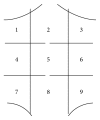Adhesions to Mesh after Ventral Hernia Mesh Repair Are Detected by MRI but Are Not a Cause of Long Term Chronic Abdominal Pain
- PMID: 26819601
- PMCID: PMC4706901
- DOI: 10.1155/2016/2631598
Adhesions to Mesh after Ventral Hernia Mesh Repair Are Detected by MRI but Are Not a Cause of Long Term Chronic Abdominal Pain
Abstract
Aim. The aim of the present study was to perform MRI in patients after ventral hernia mesh repair, in order to evaluate MRI's ability to detect intra-abdominal adhesions. Materials and Methods. Single-center long term follow-up study of 155 patients operated for ventral hernia with laparoscopic (LVHR) or open mesh repair (OVHR), including analyzing medical records, clinical investigation with patient-reported pain (VAS-scale), and MRI. MRI was performed in 124 patients: 114 patients (74%) after follow-up, and 10 patients referred for late complaints after ventral mesh repair. To verify the MRI-diagnosis of adhesions, laparoscopy was performed after MRI in a cohort of 20 patients. Results. MRI detected adhesions between bowel and abdominal wall/mesh in 60% of the patients and mesh shrinkage in 20-50%. Adhesions were demonstrated to all types of meshes after both LVHR and OVHR with a sensitivity of 70%, specificity of 75%, positive predictive value of 78%, and negative predictive value of 67%. Independent predictors for formation of adhesions were mesh area as determined by MRI and Charlson index. The presence of adhesions was not associated with more pain. Conclusion. MRI can detect adhesions between bowel and abdominal wall in a fair reliable way. Adhesions are formed both after open and laparoscopic hernia mesh repair and are not associated with chronic pain.
Figures
Similar articles
-
Long term recurrence, pain and patient satisfaction after ventral hernia mesh repair.World J Gastrointest Surg. 2015 Dec 27;7(12):384-93. doi: 10.4240/wjgs.v7.i12.384. World J Gastrointest Surg. 2015. PMID: 26730284 Free PMC article.
-
Pain and convalescence following laparoscopic ventral hernia repair.Dan Med Bull. 2011 Dec;58(12):B4369. Dan Med Bull. 2011. PMID: 22142580 Clinical Trial.
-
Long-term quality of life and functionality after ventral hernia mesh repair.Surg Endosc. 2016 Nov;30(11):5023-5033. doi: 10.1007/s00464-016-4850-9. Epub 2016 Mar 11. Surg Endosc. 2016. PMID: 26969665
-
Ventral hernia repair by the laparoscopic approach.Surg Clin North Am. 2000 Aug;80(4):1329-40. doi: 10.1016/s0039-6109(05)70228-0. Surg Clin North Am. 2000. PMID: 10987039 Review.
-
Current Trends in Laparoscopic Ventral Hernia Repair.JSLS. 2015 Jul-Sep;19(3):e2015.00048. doi: 10.4293/JSLS.2015.00048. JSLS. 2015. PMID: 26273186 Free PMC article. Review.
Cited by
-
Surgical and radiological behavior of MRI-depictable mesh implants after TAPP repair: the IRONMAN study.Hernia. 2019 Dec;23(6):1133-1140. doi: 10.1007/s10029-019-02019-2. Epub 2019 Jul 31. Hernia. 2019. PMID: 31367964 Free PMC article.
-
Postoperative ileus after laparoscopic primary and incisional abdominal hernia repair with intraperitoneal mesh (DynaMesh®-IPOM versus Parietex™ Composite): a single institution experience.Langenbecks Arch Surg. 2021 Feb;406(1):209-218. doi: 10.1007/s00423-020-01898-9. Epub 2020 May 31. Langenbecks Arch Surg. 2021. PMID: 32504204
-
Adhesions After Laparoscopic IPOM-How Serious Is the Problem?J Abdom Wall Surg. 2025 Mar 26;4:14126. doi: 10.3389/jaws.2025.14126. eCollection 2025. J Abdom Wall Surg. 2025. PMID: 40206847 Free PMC article. Review.
-
From Meshes to Minimally Invasive Techniques: A Comprehensive Review of Modern Hernia Repair Approaches.Cureus. 2024 Aug 5;16(8):e66206. doi: 10.7759/cureus.66206. eCollection 2024 Aug. Cureus. 2024. PMID: 39233930 Free PMC article. Review.
-
Step-by-step guide to safe removal of pre-peritoneal inguinal mesh.Surg Endosc. 2019 Aug;33(8):2680-2685. doi: 10.1007/s00464-018-6558-5. Epub 2018 Oct 24. Surg Endosc. 2019. PMID: 30357522
References
-
- Fischer T., Ladurner R., Gangkofer A., Mussack T., Reiser M., Lienemann A. Functional cine MRI of the abdomen for the assessment of implanted synthetic mesh in patients after incisional hernia repair: initial results. European Radiology. 2007;17(12):3123–3129. doi: 10.1007/s00330-007-0678-y. - DOI - PubMed
LinkOut - more resources
Full Text Sources
Other Literature Sources



